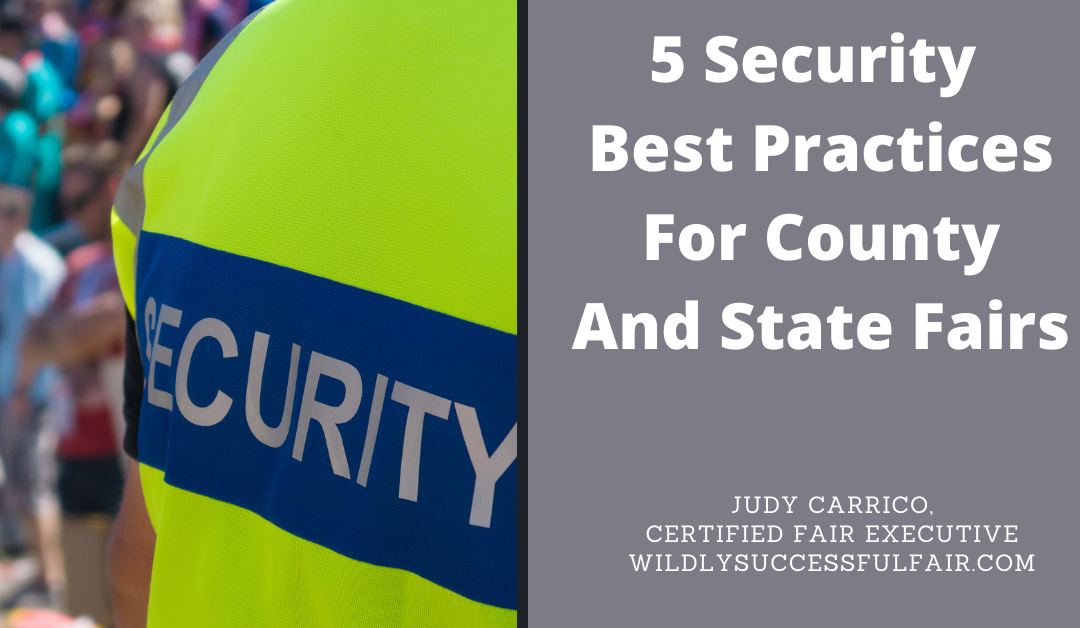
5 Best Security Practices For County and State Fairs
As many fairgrounds return to holding large scale events, including their annual fair, it’s time to re-evaluate your organizations fairtime security processes and policy(s). Another reason to do this – the high turnover of Fair Management and Staff due to Covid 19. Between layoffs and retirements, a large number of fairs across the United States have new leadership in their organization. Some of these individuals have prior fair experience or event management experience, and yet, many come from non-fair industry/non-event management careers. Regardless of your status, take a minute to read the following helpful information.
It’s your first (or 20th) fair, opening day, you have just opened your gates, and you get a call from your head of security who is reporting a security issue at your admission gate. An individual has arrived at your admission gate with a boa constrictor wrapped around their neck, and is demanding access to your grounds with the boa constrictor. This individual claims that this is an emotional support animal. Your head of security has denied access based on your policy: service animals are allowed which does not include emotional support animals. Information regarding service animals is posted on your website, in the parking lot and admission gate. Your security team has been trained in ADA protocol. After some back and forth, the individual leaves, and informs you of their intent to file a lawsuit for ADA discrimination. Your head of security returns to their office to write up a brief report. You return to your office and write up a brief report. Pertinent information includes date, time, location, and what transpired. Fair continues, and two days later, you receive a letter from the individuals attorney indicating their intent to file suit for discrimination.
Your attorney has been called in, and asks for a copy of your security policies, admission procedures, staff training, etc. Can you provide that information and documentation? If so, congratulations, it’s time to continue that process and on-going staff training. If you have no idea what the attorney is referring to or if you haven’t experienced an incident or crisis (large or small scale) it’s definitely time to begin learning what your responsibility is as leader for your organization.
Here are 5 best security practices that can easily be implemented regardless of the size of your organization and fair. These are all low cost yet effective ways to reduce your risk of liability for your organization. Make sure to document each step you take.
#1 – Helpful Information on Website:
In today’s cell phone based living style, make sure that your website is mobile friendly first. Use this free tool from google to check https://search.google.com/test/mobile-friendly.
Next, you need to have an FAQ section, What To Know Before You Go section or someplace on your website that you can provide information to your attendees. Here is an example of a fair’s “Visitor Policy” page on their website.
This information provides your guest(s) with adequate information to prepare for their visit to your fair. Using color codes of green for what’s allowed and red for what’s prohibited is a good idea for most people to know green is go and red is stop.
#2 Post Signage In Parking Lots and By Admission Gates
Having information online is great, however, it’s also important to list in your parking lots and by your admission gates. Depending on your demographic, you may consider having the information translated into other languages. Here are two examples of signage to consider:
I would encourage you to ‘brand’ your signage to include your organization’s logo at a minimum. This way, if you do need to provide documentation. It’s obvious that the signage was for your event.
# 3 – Conduct A Pre-Fair Security Table Top Exercise
At least 2 months prior to Fair your organization should conduct a ‘table top’ exercise addressing a potential situation that could happen at your facility. Participants should include law enforcement (sheriff, police department, state police, etc), private security, ambulance, first aid, fair management team (including any supervisor level positions). In addition, Lead Staff from the following fair related departments should participate: Admissions, Parking, Maintenance, Administration, Racing (Auto/Horse), Competitive Exhibits, Concessions and Retail Vendors, HR, and Entertainment.
In many cases, there are always new personnel in their roles at the different agency’s the fair would work with. Bringing everyone together in one room and having introductions (name and role at the fair) will allow for putting a ‘name to a face’. Your fair team knows each other, those outside your organization need to understand your team’s roles and area’s of responsibility.
Potential incidents to plan for: Active Shooter, Power Outage, Bomb Threat, Fire, Robbery, Fire, weather related activities, earthquake or anything you’ve seen happen in the news. Keep a record of which topics were reviewed and what years. Again, it will help if you ever need to present that information in a court of law.
#4 – Trained Crowd Manager Training Opportunities
The International Association of Venue Management has a quality program for anyone who will have a role of responsibility at your facility (aka anyone who is a supervisor and higher level in the organization). At a minimum lead personnel from the following departments should be trained: Parking, Admissions, Security, Competitive Exhibits (all department superintendents), Food and Retail Vendors and HR. The cost for this 6 hour training is nominal. It will provide your team with a high level of training in crowd management. It will also give your team the confidence to handle a situation that will arise during their role in your organization.
Here is the link for the IAVM’s Trained Crowd Manager site: https://www.trainedcrowdmanager.com/#/home/
#5 – Post A Security Phone Number/Emergency Number for Public To Call
Assign one phone number to be used by the public to call in the event that they see something, or need emergency assistance while on your grounds. In many places, dialing 911 will result in the call being diverted to a regional call center rather than a local dispatcher. Find out from your local law enforcement how their 911 system works. It’s possible that your contact can find a work around to the 911 system.
I’ve worked at Fairs that had an ambulance show up that was not dispatched by our first aid – a patron had called into the 911 service, which was a regional dispatch in a county over 90 minutes away. We had to scramble to get the ambulance directed to the correct gate closest to the incident. After that incident, our team worked with the local sheriff and fire department (our law enforcement and first aid providers) to insure all 911 calls for incidents at the fairgrounds were re-routed to our onsite sheriff dispatch office.
So there you have 5 Security Best Practices that can easily be implemented at your organization:
#1 – Helpful Information On Website
#2 – Post Signage In Parking Lots And By Admission Gates
#3 – Conduct A Pre-Fair Security Table Top Exercise
#4 – Trained Crowd Manager Programs
#5 – Post A Security Phone Number/Emergency Number for Public To Call
By implementing these 5 best practices you’ll be prepared for when that incident happens and how you and your team respond. You’ll also be able to defend your actions in a court of law – if that becomes the case.
WildlySuccessfulFair.com was created to help County and State Fair Management Teams in planning their annual fair. From selling more tickets, to making your fair safer, we strive to provide relevant information from successful fairs across the United States. Make sure to Follow and Like us on Facebook and Instagram.
If you have a topic you’d like more information on, please email us judy@wildlysuccessfulfair.com. We’d love to hear from you.
To receive timely notices of our newest posts sign up for our newsletter.

